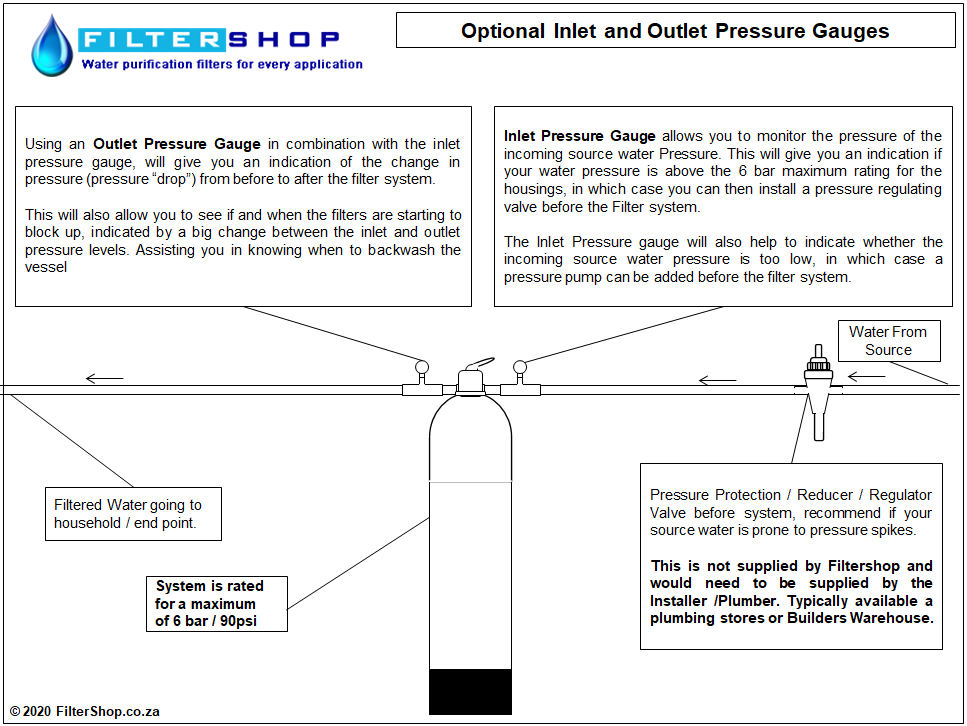Deep Bed Sand Filter Vessels
- Deep Bed Sand Filter is used to capture sediment, dirt, rust and other particles from water.
- The Silica Sand Held Inside of the vessel, filters to a nominal micron rating of 100 Micron.
- The silica sand is reusable and can be back washed to remove the particles captured inside.
- The Silica sand will have to be replaced every 2 to 5 years, depending on the quality of the source water.Typically the silica sand will need to be replaced because of blockage or bacterial/micro organism growth on the surface of the silica sand. The sand can be purchased from pool shops or builders warehouse.
- The Deep Bed Sand Filter vessels are more effective at sediment removal than the standard short stubby pool sand filter units. This is because the water has to flow through all the sand from the top of the vessel, right to the bottom of the vessel. This means that the water has a longer exposure time to the sand, and so more particles, dirt, rust, and sediment will be captured.
Deep Bed Sand Filter Vessel Normal Operation and Backwashing
During Normal, operation water flows into the top of the vessel and travels all the way to the bottom of the vessel. As the water flows down through the vessel, all the particles, rust, dirt, mud, and other sediment is captured between the filter sand granules. The water then enters the bottom strainer, flows up the riser pipe, and out the top of the vessel.



Deep Bed Sand Filter Vessel Sizes
25 Litre Media Vessel
- 8 x 44" Fibre Glass Vessel
- Holds 1 Bag of Silica Filter Sand
- For Flow Rates +/- 1000 Litres Per Hour
50 Litre Media Vessel
- 10 x 54" Fibre Glass Vessel
- Holds 2 bags of Silica Filter Sand
- For Flow Rates +/- 1500 Litres Per Hour
75 Litre Media Vessel
- 13 x 54" Fibre Glass Vessel
- Holds 3 Bags of Silica Sand
- For Flow Rates +/- 2500 Litres Per Hour
100 Litre Media Vessel
- 14 x 65" Fibre Glass Vessel
- Holds 4 Bags of Silica Sand
- For Flow Rates +/- 3500 Litres Per Hour
Valve Head Options
Manual Valve Head
- Does not require any power.
- Backwashing must be done manually.
Automatic Valve
- Requires an electrical source to operate (requires a normal 2 pin or 3 pins plug)
- Can be set to automatically backwash the vessel, with either fleck or digital time.
- Please note the Automatic valve will either be a fleck or digital valve, depending on stock availability. A manual for programming the valve head will be provided with the unit.
How to install the Deep Bed Sand Filter Vessel
Programming the Digital Automatic Valve Head
Additional Options
Optional Inlet and Outlet Pressure Gauges
Inlet Pressure Gauge allows you to monitor the pressure of the incoming source water Pressure. This will give you an indication of your water pressure is above the 6 bar maximum rating for the housings, in which case you can then install a pressure regulating valve before the filter system.
The Inlet Pressure gauge will also help to indicate whether the incoming source water pressure is too low, in which case a pressure pump can be added before the filter system.
Using an Outlet Pressure Gauge in combination with the inlet pressure gauge will give you an indication of the change in pressure (pressure “drop”) from before to after the filter system.
This will also allow you to see if and when the filters are starting to block up, indicated by a big change between the inlet and outlet pressure levels. Assisting you in knowing when to replace the filter cartridges inside.
Please note that pressure gauges are built to order, construction time is 2 to 3 working days.

PVC Threaded and Glue Fittings
PVC(Polyvinyl chloride) fittings are used to connect sections of pipes or tubes, adapt to different sizes or shapes, and controlling the flow of water. There are two predominant types of PVC fittings namely PVC Glue Fittings and PVC Threaded Fittings. The difference between the two is that PVC Glue Fittings result in permanent joints and PVC Threaded Fittings are semi-permanent and can be replaced. PVC Glue fittings are joined with primer and cement- a chemical solvent that melts the surface of the PVC and then quickly re-hardens to fuse the pieces together. This results in an airtight, leak-proof bond similar to what you get with welding metal. An example of such a fitting is a PVC Glue Reducing Socket which is used to join together two pieces of PVC pipes with different diameters. Another example would be a 90 Degree Elbow which is used to connect two pipes of the same diameter at an angle of 90 degrees.PVC Threaded fittings utilise a simple threaded connection whereby replaceable 'male threaded' are screwed into 'female threaded'.Male threads have a thread on the outside of the fitting and female threads have a thread on the inside. When you thread the fitting in, it compresses against the other threads.PTFE tape is used to thread these together and the proper way to assemble threaded fittings is to finger tighten, then add one to two turns but no more. An example of a threaded fitting is a Reducing Nipple Male Threaded which is used to connect between two female threads of different diameters.
Link To PVC Fittings
























































